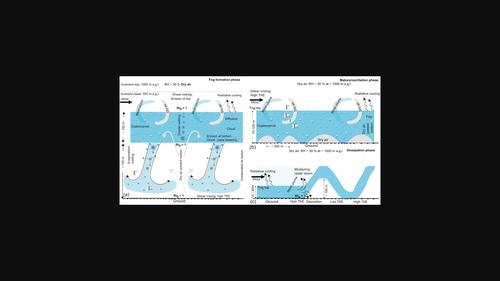A case study of the life cycle of a stratus‐lowering coastal‐fog event in Newfoundland, CA
IF 3
3区 地球科学
Q2 METEOROLOGY & ATMOSPHERIC SCIENCES
引用次数: 0
Abstract
We present a case study of a coastal‐fog stratus‐cloud lowering event on 13–14 September 2018 during the C‐FOG field campaign conducted along the east coast of Newfoundland, Canada. The goal of this work is to understand the mechanisms governing the life cycle of a four‐hour‐long coastal‐fog event that resulted from the complex interplay of dynamic, thermodynamic, and microphysical processes. In addition to standard meteorological measurements, turbulence, irradiance, droplet‐size spectra, tethered‐balloon wind and thermodynamic profiles, visibility, precipitation and spatial heterogeneity of microphysics measurements are presented to discriminate and interpret the fog formation, development, and dissipation. After sunset, strong radiative cloud‐top cooling induced top‐down convection length scales that can be characterised with the Thorpe scale. Top‐down mixing and turbulent kinetic energy (TKE) generated due to buoyant/shear mixing are characterised using the flux and bulk Richardson number near the surface. Use of these parameters is unique in the analysis of fog events and helped described mixing processes. Downward mixing led to fog droplet formation that precipitated from the cloud base, which in turn cooled the sub‐cloud layers via droplet evaporation and moistened the air beneath the cloud. Once fog formed, it was affected by dry‐air entrainment from its top. As a result, the fog thinned, creating patchy fog that was characterised by remarkable oscillations in visibility near the surface. Dissipation of the fog was driven by strong turbulence above the fog layer and horizontal thermal advection demonstrated using the temperature tendency equation. This work provides novel measurements and analysis techniques that have previously not been used to understand the mechanisms governing stratus‐lowering events. These observations and analyses help highlight processes and explain mechanisms related to the fog life cycle that are inherently challenging to predict in mesoscale models. This article is protected by copyright. All rights reserved.

加利福尼亚纽芬兰一次降低层位的沿海雾事件生命周期的案例研究
我们对2018年9月13日至14日在加拿大纽芬兰东海岸进行的C - fog现场活动期间的沿海雾层云下降事件进行了案例研究。这项工作的目标是了解由动力学、热力学和微物理过程的复杂相互作用造成的长达4小时的沿海雾事件的生命周期的控制机制。除了标准的气象测量外,湍流、辐照度、液滴大小光谱、系留气球风和热力学剖面、能见度、降水和微物理测量的空间异质性也被提出来区分和解释雾的形成、发展和消散。日落后,强辐射云顶冷却诱导自上而下的对流长度尺度,可以用索普尺度来表征。自上而下的混合和由浮力/剪切混合产生的湍流动能(TKE)是用表面附近的通量和体积理查德森数来表征的。这些参数的使用在雾事件的分析中是独一无二的,并有助于描述混合过程。向下的混合导致雾滴的形成,这些雾滴从云底沉淀下来,反过来通过雾滴蒸发冷却了云下层,并湿润了云下的空气。雾一旦形成,就会受到其顶部夹带的干空气的影响。结果,雾变薄了,形成了斑块状的雾,其特征是在地表附近能见度的显著波动。雾的消散是由雾层上方的强湍流驱动的,并用温度趋势方程证明了水平热平流。这项工作提供了新的测量和分析技术,以前没有被用来理解控制层下降事件的机制。这些观测和分析有助于突出过程和解释与雾生命周期相关的机制,这些过程和机制在中尺度模式中固有地具有挑战性。这篇文章受版权保护。版权所有。
本文章由计算机程序翻译,如有差异,请以英文原文为准。
求助全文
约1分钟内获得全文
求助全文
来源期刊
CiteScore
16.80
自引率
4.50%
发文量
163
审稿时长
3-8 weeks
期刊介绍:
The Quarterly Journal of the Royal Meteorological Society is a journal published by the Royal Meteorological Society. It aims to communicate and document new research in the atmospheric sciences and related fields. The journal is considered one of the leading publications in meteorology worldwide. It accepts articles, comprehensive review articles, and comments on published papers. It is published eight times a year, with additional special issues.
The Quarterly Journal has a wide readership of scientists in the atmospheric and related fields. It is indexed and abstracted in various databases, including Advanced Polymers Abstracts, Agricultural Engineering Abstracts, CAB Abstracts, CABDirect, COMPENDEX, CSA Civil Engineering Abstracts, Earthquake Engineering Abstracts, Engineered Materials Abstracts, Science Citation Index, SCOPUS, Web of Science, and more.

 求助内容:
求助内容: 应助结果提醒方式:
应助结果提醒方式:


